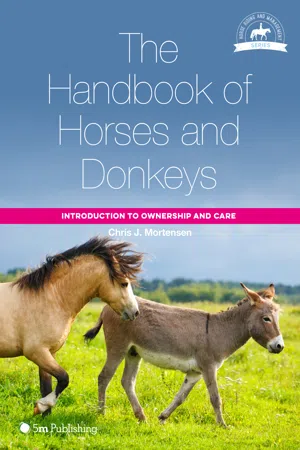
The Handbook of Horses and Donkeys: Introduction to Ownership and Care
- English
- ePUB (mobile friendly)
- Available on iOS & Android
The Handbook of Horses and Donkeys: Introduction to Ownership and Care
About this book
Horses and donkeys continue to be important to most societies as either recreational or working animals. Presenting a broad coverage of topics relating to horse and donkey ownership, The Handbook of Horses and Donkeys is an introductory guide providing expert advice on current ethical management practices.The history, evolution and domestication of equids is covered, along with equine anatomy and physiology, nutrition, behaviour, learning and cognition, communication, equine health and disease, hoof care, first aid, parasitic infections, preventive measures, pregnancy and foal management.The book is practical, guiding the reader towards good management and best practice. Functional topics are also covered, including body condition scoring, estimating body weight, calculating dietary rations, stabling, pasture advice and management of abnormal behaviours and stereotypies. The approach is holistic, with a global perspective of the care and different uses of equines worldwide and of equine health in relation to the global spread of infection and diseases.The information presented is expert-led but written in an informative and accessible way, designed to be applicable to the novice or experienced owner.
Frequently asked questions
- Essential is ideal for learners and professionals who enjoy exploring a wide range of subjects. Access the Essential Library with 800,000+ trusted titles and best-sellers across business, personal growth, and the humanities. Includes unlimited reading time and Standard Read Aloud voice.
- Complete: Perfect for advanced learners and researchers needing full, unrestricted access. Unlock 1.4M+ books across hundreds of subjects, including academic and specialized titles. The Complete Plan also includes advanced features like Premium Read Aloud and Research Assistant.
Please note we cannot support devices running on iOS 13 and Android 7 or earlier. Learn more about using the app.
Information
Chapter 1
History of Equidae

- Describe the evolution of equids over the past 55 million years
- Understand the interrelationships of both modern domestic and exotic species of Equidae
- Explain the history of domestication of horses and donkeys.
Equidae
Equid
Evolution
Equine
Evolution of Today’s Modern Horses and Donkeys

| Classification | Division | Description |
| Kingdom | Animalia | Multicellular organisms |
| Phylum | Chordata | Possess a hollow nerve chord, notochord |
| Class | Mammalia | Warm–blooded vertebrates; characterized by having hair and females with mammary glands |
| Order | Perissodactyla | Odd–toed ungulates and hind–gut fermenters; equids, rhinoceros, and tapir |
| Family | Equidae | Current and extinct species of horses and related animals |
| Genus | Equus (E.) | Current and extinct species of horses and animals related to Equus, early ancestor to modern equids |
| Species | E. ferus caballus; E. africanus asinus; E. quagga | Scientific name given to domestic horses, domestic donkeys, and the Plains zebra |
Eohippus
Genus
Dawn horse

Table of contents
- Cover
- Half Title
- Title
- Copyright
- Contents
- Acknowledgements
- Chapter 1 History of Equidae
- Chapter 2 The World’s Equids
- Chapter 3 Basic Equine Physiology
- Chapter 4 Breeds of Horses and Donkeys
- Chapter 5 Complexities of Horse and Donkey Behavior
- Chapter 6 Feeding Horses and Donkeys
- Chapter 7 Proper Housing and Pasture Maintenance
- Chapter 8 Equine Health
- Chapter 9 Equine Reproduction
- Appendix 1 Common Breeds Listings
- Appendix 2 Height Conversion Table
- Appendix 3 Global Population of Horses and Donkeys
- Index